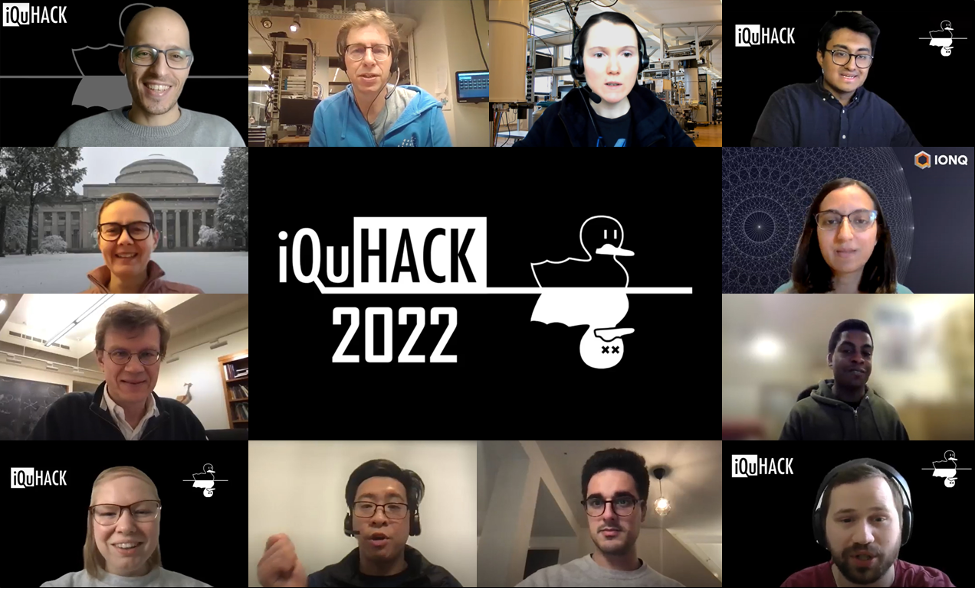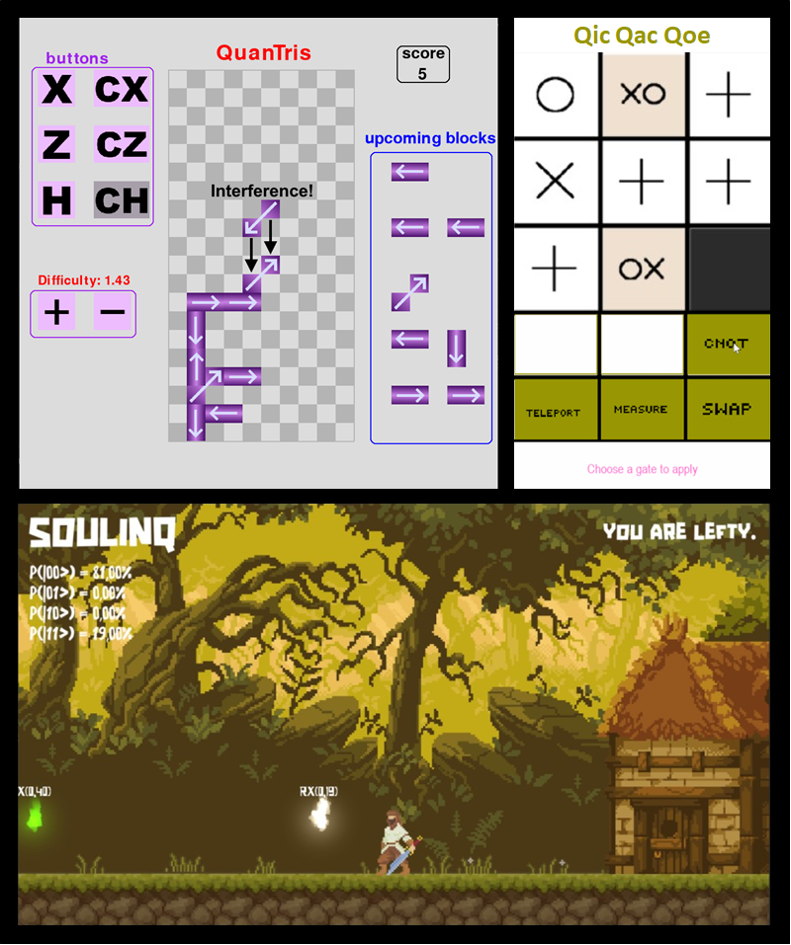MIT iQuHACK 2022: Bringing together the next generation of quantum coders
 The annual MIT quantum computing hackathon, MIT iQuHACK, was held virtually this year with 400 participants from 57 countries. Pictured are some of the hackathon’s speakers and organizing committee members. Clockwise from top left: Carlos Errando Herranz, Richard Versluis, Mariia Mykhailova, Shantanu Jha, Sonika Johri, Tumi Aluko, Eric Bersin, Miguel Moreira, Jerry Chow, Maddie Sutula, Mikhail Lukin, Paola Capellaro.
Image courtesy of MIT iQuHACK
The annual MIT quantum computing hackathon, MIT iQuHACK, was held virtually this year with 400 participants from 57 countries. Pictured are some of the hackathon’s speakers and organizing committee members. Clockwise from top left: Carlos Errando Herranz, Richard Versluis, Mariia Mykhailova, Shantanu Jha, Sonika Johri, Tumi Aluko, Eric Bersin, Miguel Moreira, Jerry Chow, Maddie Sutula, Mikhail Lukin, Paola Capellaro.
Image courtesy of MIT iQuHACK
On the morning of Friday, January 28, California Polytechnic State University undergraduate students Alexander Knapen and Nayana Tiwari and graduate student Julian Rice had never programmed on quantum computers before. Fifty hours later, on Sunday, January 30, they had built an online quantum chat server that encrypts messages using quantum algorithms.
Knapen, Tiwari, and Rice had worked tirelessly on the chat server over an adrenaline-fueled weekend at the third annual MIT Interdisciplinary Quantum Hackathon (iQuHACK, pronounced “i-quack”, like the duck in the hackathon’s logo). At iQuHACK, 400 people from 57 countries gathered virtually to design and build quantum computing projects from scratch. Participants had the chance to code on real quantum computers, a major highlight of the hackathon because so few are available today. In particular, hackers had free access to IonQ’s quantum computer (via Microsoft’s Azure Quantum service) and QuTech’s Quantum Inspire platform.
“Today, you can [easily] make an app [for phones or normal computers] and put it on the app store. We’re not there yet for quantum computing, but events like this hackathon start to make it possible” to think about greater accessibility to quantum computing applications, said Matthew Keesan, Vice President of Development at IonQ.
While all iQuHACK participants had access to quantum computers, they arrived at the hackathon with different levels of experience. Some hackers came in with experience programming quantum computers – computers that use quantum mechanics to solve problems too difficult for normal ‘classical’ computers, with applications such as stronger encryption methods for more secure messaging and complex molecular simulation for faster drug development – but others, like Knapen, Tiwari, and Rice, needed to learn on-the-fly. Knowing this, the hackathon’s chair, MIT postdoctoral researcher Carlos Errando Herranz, sought to make learning as easy as possible, empowering everyone to bring their ideas to life. “We wanted people to learn first-hand that coding on quantum computers is not as hard as it sounds,” he said.
The first day of iQuHACK brought participants up to speed with the nuts-and-bolts of quantum computing. Hackers could attend tutorials on how to use the IonQ/Microsoft and Quantum Inspire platforms and also drop into ‘office hours’ for help with setting up the necessary software tools. Later, when the hackathon was in full swing, participants could seek guidance on their projects from experienced quantum computing professionals in industry and academia, who served as hackathon mentors. “The most intimidating thing is to get something working,” Knapen said of the online quantum chat server, “But once we had an idea of what we wanted to do, it was pretty easy to get the code written and up and running.”
The chat server project, called Keytanglement, ran on the Quantum Inspire platform, the first publicly available quantum computing platform in Europe. “We can actually see it running live” on the platform, said Richard Versluis, system architect of the Quantum Inspire, “When you go to their website and execute on your telephone what they did, you see the [chat server’s encryption] ‘job’ being submitted, [the Quantum Inspire] running the [encryption] algorithms, then [the results] going back to the web server.”
Hackers with more quantum computing experience also took advantage of their access to quantum computers. One team of five Yale University undergraduate students spent the weekend delving into the nitty-gritty details of how quantum computers implement quantum code. In “quantum hardware development, looking at how various [operations] can be implemented is such an active field of study,” said Alex Deters, one of the Yale team members. Often, a direct translation between quantum code and hardware is not possible, resulting in errors in the results. These error rates depend on the specific hardware being used.
“Knowing that we would be working with [quantum computers, we thought] it would be great to benchmark the hardware[‘s error rates],” Deters said. To do this, the team built a benchmarking tool, “reminiscent of standard computer science tools,” that can provide the error rates for any quantum computer and help find the most accurate quantum algorithms for the specific hardware. The tool, called Quantum RX, ran successfully on the Quantum Inspire platform and provided “very valuable” feedback, Versluis said.
Despite being a virtual event, iQuHACK created a strong sense of community, bringing together quantum computing enthusiasts from around the world. Many hackers capitalized on the virtual format, forming teams with members scattered across multiple countries. Frederik Hardervig, an undergraduate student studying in Germany this semester, had participated in iQuHACK last year as a one-person team and was extremely eager to assemble a multi-person team this year. “As soon as I saw [participants] Tomasz [Kazulak] and Danai [Bili] write in the ‘looking-for-a-team’ [Slack channel] and say they were from Europe, I wrote them and was like ‘can we team please?’“ Hardervig said. At the time, Kazulak was in Poland and Bili was in England. The three of them then rounded out their team with two more members, Caspian Chahrom, who was in Switzerland, and Sneha Shakya, who was in the US. “It was cool to meet people from around the world who are doing the same thing,” Chahrom said.
Together, the five newly acquainted hackers collaborated remotely and built a new Tetris game on the IonQ/Microsoft platform. The game, called QuanTris, works similarly to Tetris, but with a quantum twist – the falling blocks are governed by the rules of quantum mechanics. Through QuanTris, the hackers hoped to teach players quantum computing concepts in a fun way.

With 75 projects being built at the hackathon, the IonQ/Microsoft and Quantum Inspire platforms were heavily used. Both platforms included quantum computers as well as quantum simulators, where people could test their code or play with ideas that required greater computing ability than the hardware could currently provide. For the IonQ/Microsoft platform, which made one quantum computer available, “the demand was amazing,” Keesan said, “We ran something like 50,000 simulations and 1,000 quantum programs during the hackathon.” For the Quantum Inspire platform, two quantum computers were available, each using a different quantum technology. “All our systems kept running for the full weekend,” Versluis said, even with “tens of people accessing the system at the same time.”
In addition to working on their hackathon projects, participants could attend talks by quantum computing experts to get a broader view of the field today. Professor Mikhail Lukin of Harvard University gave iQuHACK 2022’s keynote talk, providing historical and technical background on quantum computing. Professor Paola Capellaro of MIT then kicked off the hacking portion of iQuHACK with opening remarks on future directions in quantum computing applications. Experts across industry also gave a series of technical talks, presenting updates on their companies’ efforts in quantum computing. “I learned a lot about the current state of the art and [where] the field is moving,” said Hieu Dinh, an MIT undergraduate. (Dinh was part of a team of MIT undergraduates who had built a quantum version of Tic Tac Toe, called Qic Qac Qoe, at the hackathon.)
The iQuHACK 2022 tutorials, talks, and other quantum computing resources, including participants’ projects from this year and last year, are publicly available on the hackathon’s Twitch streaming channel and website. As Errando Herranz winds down his tenure as iQuHACK’s chair, he encourages anyone interested in quantum computing to use these resources to “start learning now,” especially if they’re looking to participate in the hackathon next year.
“With quantum, when you’re learning in the classroom, you’re handed everything. This hackathon is the first time we were able to generate an idea and actually implement it,” Tiwari of the Keytanglement project said, “I’m excited to take that [experience] and continue working on projects [in quantum computing].”
iQuHACK 2022 was hosted by the MIT Interdisciplinary Quantum Information Science and Engineering (iQuISE) program, a student-run group of MIT graduate students and postdocs. This year’s organizing iQuHACK committee consisted of Carlos Errando Herranz, Shantanu Jha, Jawaher Almutlaq, Shoumik Chowdhury, Hamza Raniwala, Maddie Sutula, Eric Bersin, and Michael Walsh.
In addition to the three major platform sponsors, IonQ, Microsoft, and QuTech, the hackathon was sponsored by Google Quantum AI, IBM Q, HRL Laboratories, Zapata Computing, Zurich Instruments, QuEra Computing Inc., qBraid, MIT, the Research Laboratory of Electronics at MIT, the MIT EECS Department, and the MIT Center for Quantum Engineering.
Media Inquiries
Journalists seeking information about EECS, or interviews with EECS faculty members, should email eecs-communications@mit.edu.
Please note: The EECS Communications Office only handles media inquiries related to MIT’s Department of Electrical Engineering & Computer Science. Please visit other school, department, laboratory, or center websites to locate their dedicated media-relations teams.